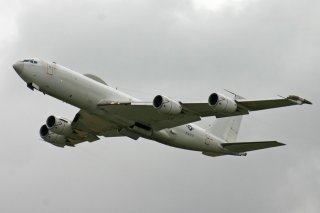If America's Nuclear Triad Fails, The E-6 Mercury Could Be Our Saving Grace
The Mercury could launch a Minuteman III ICBM from the air.
Here's What You Need To Remember: Air-launch can help optimize the launch process, given that ICBM silos are dispersed across a wide swath of three states, including expansive land areas in Montana and Wyoming. Should some ICBMs be disabled, an air launcher might be well suited to locate the best launch opportunities.
Imagine if America’s land-based intercontinental ballistic missile (ICBM) launch silos were destroyed, its nuclear-armed ballistic missile submarines have been found and neutralized, and its nuclear bombers cannot get over enemy airspace. All the while, during this nightmare, the continental United States itself is suffering a catastrophic nuclear weapons attack. This scenario is highly unlikely, but not impossible.
In such an event, there would be few or even zero options to retaliate against the aggressor to assure mutual destruction or simply halt the attack.
These types of contingencies point precisely to the reason why the U.S. nuclear triad exists. It is specifically constructed to ensure a decisive retaliatory strike. Such an ability, drawing upon nuclear-armed aircraft, land-based ICBMs and submarine-launched nuclear weapons, guarantees a massive response, thereby keeping the peace. Indeed, the U.S. nuclear triad has been effective for decades.
What if, as posited, there did not appear to be a way to launch nuclear weapons because all existing modes of nuclear attack and command and control were destroyed or neutralized? Would the United States be doomed to cataclysmic destruction?
Maybe not. The U.S. Air Force and Navy just tested an aircraft-mounted ICBM launcher able to fire off a massive nuclear attack from the air, using a technology called the Airborne Launch Control System.
An unarmed Minuteman III ICBM, equipped with three test reentry vehicles, was successfully launched from a Navy E-6 aircraft.
“A joint team of Air Force Global Strike Command Airmen and Navy sailors launched an unarmed Minuteman III intercontinental ballistic missile equipped with three test reentry vehicles from aboard the Airborne Launch Control System at 12:21 a.m. Pacific Time Aug. 4 from Vandenberg Air Force Base, California,” an Air Force report stated.
An air-coordinated launch brings new tactical mobility to the prospect of a nuclear attack, as an ICBM brings much more potential devastation than a smaller, air-dropped nuclear bomb from a B-2.
Also, air-launch can help optimize the launch process, given that ICBM silos are dispersed across a wide swath of three states, including expansive land areas in Montana and Wyoming. Should some ICBMs be disabled, an air launcher might be well suited to locate the best launch opportunities.
There is certainly no mistaking the current global tensions and threat environment, yet of course, the Air Force report was careful to include the “test launches are not a response or reaction to world events or regional tensions.”
The reentry vehicles traveled more than 4,000 miles during the test, in a clear demonstration of the intercontinental ability of the nuclear weapon.
Interesting that a Minuteman III was used, as the decades-old weapons have, according to many, long been in need of replacement. While it has been upgraded many times throughout the years and is still functional, the age of the weapon has provided at least part of the inspiration for the current Air Force Ground Based Strategic Deterrent (GBSD) program. The Air Force is now moving along with efforts to build as many as 400 new, high-tech, more capable ICBMs intended to bring U.S. nuclear weapons capability into a new era.
The Air Force’s GBSD is already testing prototypes and making rapid developmental progress with a new class of ICBM engineered with greater reliability, targeting and flight-path navigational stability.
The GBSD is still in development, so the Pentagon seeks to successfully sustain Minuteman III functionality.
“The Minuteman III is 50 years old, and continued test launches are essential in ensuring its reliability until the 2030s when the Ground Based Strategic Deterrent is fully in place. Most importantly, this visible message of national security serves to assure our allies and dissuade potential aggressors,” Colonel Omar Colbert, 576th Flight Test Squadron commander, said in the Air Force report.
Kris Osborn is Defense Editor for the National Interest. Osborn previously served at the Pentagon as a Highly Qualified Expert with the Office of the Assistant Secretary of the Army—Acquisition, Logistics & Technology. Osborn has also worked as an anchor and on-air military specialist at national TV networks. He has appeared as a guest military expert on Fox News, MSNBC, The Military Channel, and The History Channel. He also has a Masters Degree in Comparative Literature from Columbia University. This article first appeared last month.
Image: Wikimedia.

